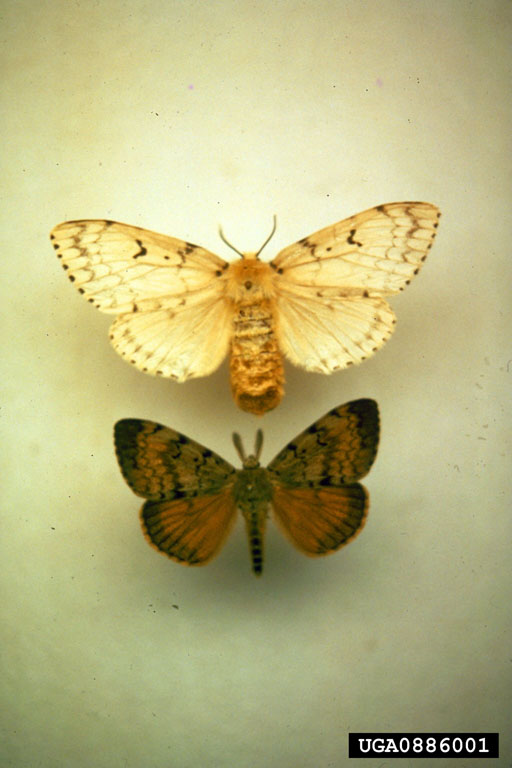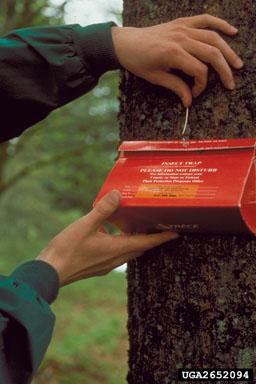Spongy Moth Survey
The spongy moth was initially introduced to the United States in Massachusetts in 1869 and is now a serious forest pest endemic to the

Male Spongy Moth (bottom)
Photo: Tim Tigner
northeastern states. The caterpillar stage feeds on more than 500 trees and shrubs with oaks being preferred. Apple, sweetgum, basswood, gray and white birch, poplar, willow, and hawthorn are also favored by all larval instars. Since 1924, more than 81 million forested acres have been defoliated by the spongy moth. The population spreads naturally through ballooning wherein very young (and small) caterpillars spin a long thread of silk into the air where it is caught by the wind. Females of the European strain of spongy moth, the most common type in North America, cannot fly, so this slows down the speed at which they can spread. However, egg cases and larvae are carried very effectively to new locations by humans. Spongy moths tend to lay their eggs in cracks and other protected places, so car wheel wells, patio furniture, campers and motorhomes, and boat trailers are often covered with the fuzzy brown egg cases or with caterpillars that have crawled inside for protection.

Photo: USDA APHIS PPQ
Kentucky is nearly surrounded by regulated, infested areas in Virginia, West Virginia, Ohio, Indiana and eastern Tennessee. From 2000-2002, West Virginia experienced record defoliations in which over 1 million acres were affected. The possibility of spongy moth spread to Kentucky is very high due to the popularity of Kentucky's recreational areas and the number of people moving into the metropolitan areas from the northeast. We have been surveying for this pest since 1983 and will continue monitoring due to the close proximity of spongy moth present in states surrounding Kentucky on all sides. This extensive trapping program pinpoints potential problems so they may be quickly eradicated before they become infestations that require the expenditure of large amounts of time and money to eradicate.
We have been very successful in keeping spongy moth out of Kentucky through close monitoring via detection and delimiting surveys. Even though this pest has become established in states surrounding Kentucky, it has not become established here. We have had three infestations in the past 25 years and all were eradicated within 3 years of discovery. Continuing and expanding the spongy moth survey in Kentucky will continue to safeguard Kentucky's high quality oak forests.
We will hire surveyors to survey wooded areas across all of Kentucky according to national protocol. Personnel will set thousands of traps in May and remove them in August. These triangular traps are baited with a synthetic female sex pheromone to attract and capture male spongy moths.
The graph below shows historical results from Kentucky's Spongy Moth trapping program.
